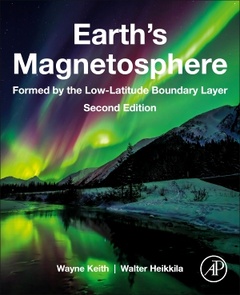Earth's Magnetosphere (2nd Ed.) Formed by the Low-Latitude Boundary Layer
Auteurs : Keith Wayne, Heikkila Walter

Geophysicists, space scientists
Walter Heikkila is Professor Emeritus in the Physics Department at the University of Texas at Dallas. His research interests include space physics and solar physics, specifically magnetospheric physics, solar wind, and auroral substorms. He received his PhD in Low Temperature Physics from the University of Toronto. He has since worked for the Defence Research Telecommunications Establishment, before becoming Associate Professor of Physics at the Southwest Center for Advanced Studies and subsequently Professor of Physics at University of Texas at Dallas. He is the author of the first edition of Earth’s Magnetosphere and a leading expert on the Earth’s magnetic field.
- Offers an historical perspective of early magnetospheric research, combined with progress up to the present
- Describes observations from various spacecraft in a variety of regions, with explanations and discussions of each
- Includes chapters on prompt particle acceleration to high energies, plasma transfer event, and the low latitude boundary layer
Date de parution : 11-2020
Ouvrage de 642 p.
19x23.3 cm
Thèmes d’Earth's Magnetosphere :
Mots-clés :
1D particle simulation; 2D; 3D; Akasofu model; AMPTE; Aurora; Auroral beads; Auroral fading; Auroral kilometric radiation; Auroral oval; Axford-Hines model; Boltzmann equation; Boltzmann-Vlasov; Buoyancy wave; CANOPUS/NORSTAR; Cause and effect; Charges; Cluster; Conductors; Convection; Current disruption; Current thinning event; Currents; Cusp diamagnetic cavity; Cusp energetic particles; Cusp throat; De Hoffman-Teller frame; Diffusion region; Dungey model; Dynamo; E·J; EISCAT; Electric; Electric field; Energy; Equation of state; Exterior cusp; Faraday; Field relations; Field-aligned current; Flank; Flux transfer event; Four-field junction; General magnetic reconnection; GEOTAIL; GUMICS; Heliophysics System Observatory; Helmholtz; ICON; IMP-8; Impulsive penetration; Inner boundary layer; International Geophysical Year; International Magnetospheric Study; Interplanetary magnetic field; Ionosphere; ISEE; ISIS; Kirchhoff; LLBL; Load; Lobes; Lorentz; Low latitude boundary layer; Low-latitude boundary layer; Magnetic; Magnetic field; Magnetohydrodynamics; Magnetopause; Magnetopause current layer; Magnetosheath; Maxwell; Maxwell's equations; MMS; Model; Near-earth neutral line; Ohm; Omega bands; Outer boundary layer; Particle acceleration; Particle energization; Particle motion; Plasma drift; Plasma sheet; Plasma transfer event; Plasma waves; Plasmasphere; Plasmoid; Polar; Polar cap; Polar caps; Polar rain; Poynting; Proton aurora; PTE; Radiation belts; RBSP; RCM; Reconnection; Resonant acceleration; Shocks; Simulation; Standard magnetic reconnection; Substorm; Substorm current wedge; Substorm transfer event; Substorms; SuperDARN; Superposed epoch analysis; THEMIS; Theta aurora; Thévenin; Thin current sheet; Thin plasma sheet; Transient penetration; Turbulence; Type 1 current; Type 2 current; Van Allan Probe; Westward traveling surge; X-line



